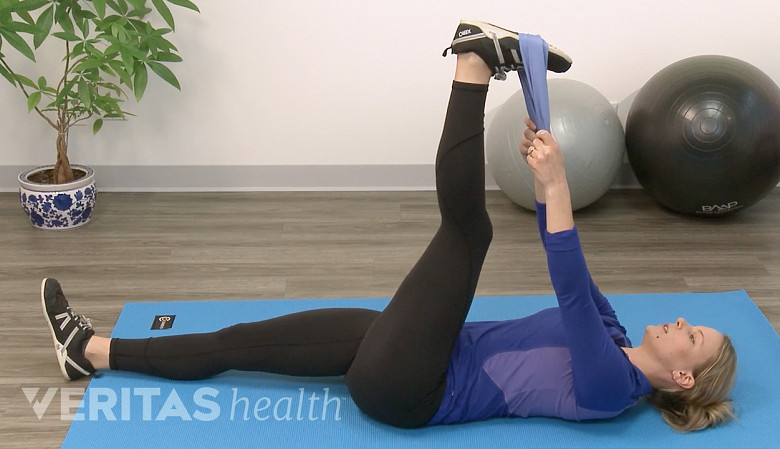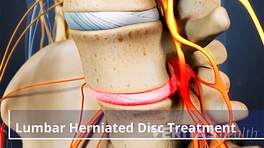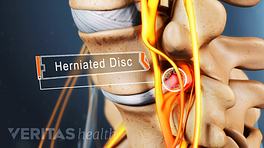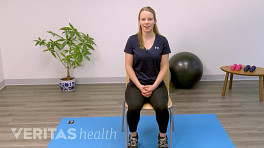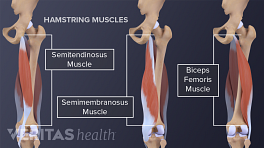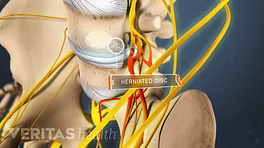Daily hamstring stretching is one of the best ways to alleviate radiating leg pain from a lumbar herniated disc.
Tight hamstrings disturb the alignment and balance between the spine, pelvis, and leg, and increase spinal stresses, especially while bending forward. 1 Lee JH, Kim TH. The treatment effect of hamstring stretching and nerve mobilization for patients with radicular lower back pain. J Phys Ther Sci. 2017;29(9):1578-1582. doi:10.1589/jpts.29.1578 , 2 Cejudo A, Centenera-Centenera JM, Santonja-Medina F. The Potential Role of Hamstring Extensibility on Sagittal Pelvic Tilt, Sagittal Spinal Curves and Recurrent Low Back Pain in Team Sports Players: A Gender Perspective Analysis. Int J Environ Res Public Health. 2021;18(16):8654. Published 2021 Aug 16. doi:10.3390/ijerph18168654 These spinal stresses further exacerbate the symptoms of a lumbar herniated disc, such as leg pain, during daily activities.
The following 3 stretches focus on loosening tight hamstrings, promoting flexibility in these muscles. Remember to stop if any exercise causes your back pain or leg pain to worsen.
In This Blog:
1. Seated hamstring stretch
This exercise stretches the muscles in your lower back and hamstrings while in a seated position.
The gentle and controlled release of muscle tension from a seated hamstring stretch alleviates back and leg pain from a herniated disc and is ideal if you have limited mobility or really tight hamstrings.
To perform this stretch:
- Sit at the edge of a chair with both feet on the ground, 3 to 6 inches apart.
- Straighten one leg in front of you, with your heel on the ground and toes pointed at the ceiling.
- Keeping your back straight, lean forward over the outstretched leg. You should feel the stretch in the back of your thighs.
- Hold this position for 15 to 30 seconds, as tolerable, and return to the starting position.
- Repeat these steps with the other leg.
To increase the intensity of the stretch, prop your heel on a stool or second chair rather than the floor.
Aim to complete 10 sets of this exercise.
2. Towel hamstring stretch
Stretching the hamstrings in a lying down (supine) position with support from a towel allows you to isolate the stretch to the hamstrings and reduce pressure on the lower back.
The towel hamstring stretch is a good option if you are a beginner, prefer to stretch while lying down, and/or have pain or stiffness in your lower back and legs.
To perform this stretch:
- Lie on your back with both legs stretched out parallel to each other.
- Gentle bend your right knee and place your right foot on the ground.
- Tighten your abdominal muscles while slowly lifting your right foot off the floor.
- Wrap a towel or yoga strap around the ball of your right foot and hold both ends of the strap.
- Gently push your right heel toward the ceiling as you straighten out your right leg. Continue to keep your left leg against the ground.
- If you cannot straighten your right leg completely, keep the right knee slightly bent.
- Once a stretch is felt in the back of your thighs, hold for about 15 to 30 seconds.
- Release your right leg back to its original position. Repeat these steps with the other leg.
Aim to complete 3 sets of this exercise on each leg.
To make the stretch more comfortable, lie on a soft surface, such as a carpet or a yoga mat, or on a padded exercise bench at your gym.
Watch Towel Hamstring Stretch for Low Back Pain and Sciatica Relief Video
3. Supported standing hamstring stretch
This variation of a standing hamstring stretch uses a stable structure, such as a countertop or table, to support the weight of your upper body and limit the pressure on your lower back as you bend forward.
The supported standing hamstring stretch allows for controlled, gradual movements to relieve pain and muscle tension while reducing the risk of worsening a herniated disc. This exercise limits forward bending and the tendency to round your lower back.
To perform this stretch:
- Find a sturdy surface that is at about waist height, and stand facing the surface with your feet hip-width apart.
- Keep an arm's length distance between your body and the surface.
- Place both hands on the surface, tighten your abdominal muscles, and hinge forward at your hips while keeping your back straight.
- Bend forward until you feel a gentle stretch in your hamstrings and hold for about 15 to 30 seconds.
- Slowly return to an upright position.
Aim to complete 3 sets of this exercise.
If you want to increase the intensity of the stretch, stand further back from the surface for a deeper stretch.
When doing any stretch, only go as far as is comfortable for you and never stretch through pain. Gradually increase the stretch over time as you gain flexibility.
If your pain worsens or does not improve, consult with a doctor or physical therapist.
Watch Standing Hamstring Stretch for Low Back Pain Relief Video
Learn more:
- 1 Lee JH, Kim TH. The treatment effect of hamstring stretching and nerve mobilization for patients with radicular lower back pain. J Phys Ther Sci. 2017;29(9):1578-1582. doi:10.1589/jpts.29.1578
- 2 Cejudo A, Centenera-Centenera JM, Santonja-Medina F. The Potential Role of Hamstring Extensibility on Sagittal Pelvic Tilt, Sagittal Spinal Curves and Recurrent Low Back Pain in Team Sports Players: A Gender Perspective Analysis. Int J Environ Res Public Health. 2021;18(16):8654. Published 2021 Aug 16. doi:10.3390/ijerph18168654
